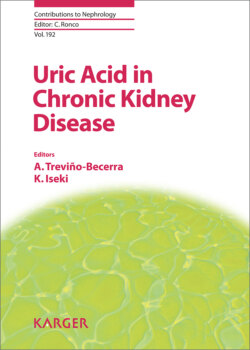Читать книгу Uric Acid in Chronic Kidney Disease - Группа авторов - Страница 15
На сайте Литреса книга снята с продажи.
Tubular Handling and Excretion of Uric Acid
ОглавлениеUric acid has no metabolic response in other tissues; it is known as a metabolic waste product and excreted by the kidneys and the intestine. Urate handling involves kidney and intestine epithelial cells encoded by the ABCG2 gene, an ATP-binding protein, alternatively referred to as Breast Cancer Resistance protein, localized on chromosome 4 [5, 6].Two-thirds of the uric acid is expelled by the kidneys, while one-thirds is eliminated by the gastrointestinal tract. Uric acid homeostasis in blood or urine samples is achieved in the form of a complex interplay proposed by Diamond and Paolino [7], which includes glomerular filtration, reabsorptive and secretory transport pathways primarily in the renal proximal tubule cell mediated by incompletely understood molecular mechanisms.
Approximately 99% of uric acid reabsorption occurs in the proximal tubule cell, and 2% left as a percentage filtered to be excreted in the final urine. Reabsorption is primarily accomplished at the S1 segment of the proximal tubule. Following reabsorption, excretion takes place at the S2 segment of the proximal tubule. Post-secretory reabsorption occurs at the S3 segment of the proximal tubule (80% of the excreted urate), and approximately 10% of the filtered uric acid appears to be excreted in the urine [1]. Even though the kidney plays an important role in uric acid balance, bidirectional transport remains partially unknown.
Fig. 2. Transport proteins involved in urate handling in the proximal tubule cell.
Filtered acid uric is reabsorbed by several proteins belonging to the organic anion transporter (OAT) family. The URAT1, a member of the OAT branch, is located on the apical membrane of the renal proximal tubule and encoded by the SLC22A12 gene, which is located on the chromosome 11q13 [2, 8]. URAT1 favours urate ion exchange by anions through the tubule for maintaining electrical balance [9]. Once there is a basolateral entry of urate into the renal proximal tubule cells, it is driven by voltage-dependent urate transport (URAT1v), which is found on the basolateral membrane, encoded by the SLC2A9, and located on chromosome 4 [10, 11]. URAT1v is known as GLUT9, reported initially as a hexose transporter (glucose and fructose) [12]. Two isoforms have been identified: GLUT9L and GLUT9S, localized on the basal and apical membranes, respectively, and they are considered the principal regulators of uric acid in humans [13, 14]. Along the tubule, other molecules favor renal reabsorption of uric acid such as sodium-coupled transporters that codify the gene SLC5A8 [15, 16]. These cotransporters play an independent and sinergical pathway in URAT1 for carboxylic acids including lactate, butyrate, nicotinate, beta-hydroxibutyrate and acetoacetate [17]. Finally, the OAT family, which encodes the SLC22 genes, is localized in the basolateral (OAT 1 and 3) and apical (OAT 2 and 4) membrane of the renal proximal tubules (Fig. 2).
Renal handling of uric acid is not just limited to the previous description; conditions associated to hyperuricemia such as gout describe various urate transporters involved in its pathophysiology such as SLC22A12, SLC2A9 [3, 11, 17,] and the SLC5A8 [15, 16] as shown in Table 1.
Table 1. Genes and binding transporter on uric acid renal handling
| ABCG2 (ATP-binding transporters of purine nucleosides) [6, 23] SLC17A1 (Sodium-dependent phosphate transporter protein 1-NPT1) [24] SLC17A3 (Sodium-dependent phosphate transporter protein 1-NPT4) [17] SLC22A11 (Solute carrier family 22: organic anion/urate transporte-OAT4) [25] SLC16A9 (Solute Carrier Family 16 Monocarboxylate transporter 9-MCT9) [25] PDZK1 (URAT1-PDZ-NPT1 domain-containing scaffolding protein) [25, 26] hUAT1 (Galectine-9 (voltage-sensible urate transport) [27] |
